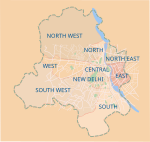Bhatnagar International School
1990 establishments in DelhiEducational institutions established in 1990Schools affiliated to CBSESchools in DelhiSouth West Delhi district ... and 1 more
Use Indian English from January 2019
Bhatnagar International School, Vasant Kunj is a private school located in sector B, Pocket 10, Vasant Kunj, India. It was founded by Dr. V.K Bhatnagar in 1990. The school has several other branches including Bhatnagar International School, Paschim Vihar, Manav Sthali School, New Rajender Nagar. It is affiliated with CBSE. The principal of the school is Shilpa Bhatnagar. The school was recognised with an International School Award by the British Council in 2021. Facilities
Excerpt from the Wikipedia article Bhatnagar International School (License: CC BY-SA 3.0, Authors).Bhatnagar International School
Abdul Gaffar Khan Marg, New Delhi Vasant Kunj (Vasant Vihar Tehsil)
Geographical coordinates (GPS) Address Nearby Places Show on map
Geographical coordinates (GPS)
| Latitude | Longitude |
|---|---|
| N 28.5302249717 ° | E 77.15329002 ° |
Address
Abdul Gaffar Khan Marg
110070 New Delhi, Vasant Kunj (Vasant Vihar Tehsil)
Delhi, India
Open on Google Maps


